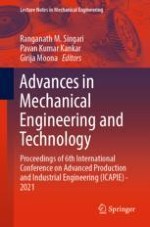This book presents the select proceedings of the International Conference on Advanced Production and Industrial Engineering (ICAPIE) - 2021 held at Delhi Technological University, Delhi, during June 18–19, 2021. The book covers the recent advances and challenges in the area of production and industrial engineering. Various topics covered include artificial intelligence and expert systems, CAD/CAM Integration Technology, CAD/CAM, automation and robotics, computer-aided geometric design and simulation, construction machinery and equipment, design tools, cutting tool material and coatings, dynamic mechanical analysis, optimization and control, energy machinery and equipment, flexible manufacturing technology and system, fluid dynamics, bio-fuels, fuel cells, high-speed/precision machining, laser processing technology, logistics and supply chain management, machinability of materials, composite materials, material engineering, mechanical dynamics and its applications, mechanical power engineering, mechanical transmission theory and applications, non-traditional machining processes, operations management, precision manufacturing and measurement, precision manufacturing and measurement, reverse engineering and structural strength and robustness. This book is useful for various researcher mainly mechanical and allied engineering discipline.
